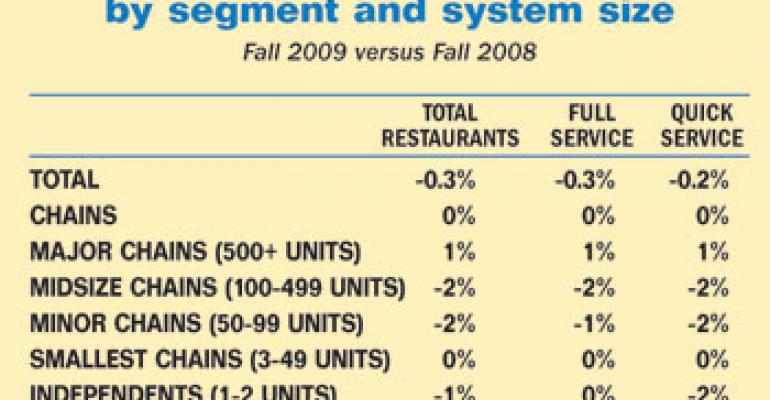CHICAGO The number of U.S. restaurants fell this past fall as the industry continued to suffer from serious declines in traffic and sales. The rate of closures, however, was less than what was reported last spring.
According to The NPD Group's ReCount data released Wednesday, the total number of U.S. restaurants declined 0.3 percent, or by 1,652 restaurants, to 578,353 locations in the fall of 2009, compared with the fall of 2008. ReCount tracks commercial restaurant locations twice a year, in the spring and fall.
Restaurant closures were more severe in the spring of 2009, when the total number of U.S. restaurants fell 1 percent from a year earlier, reflecting the loss of more than 4,000 eateries.
"NPD's fall 2009 ReCount reflects a slowdown in chains expanding, and two years of a challenging economy already weeding out the poorest performing restaurants," said Greg Starzynski, NPD's director of product development for foodservice.
The number of full-service restaurants — which NPD said comprises casual-dining, family-dining and fine-dining eateries — contracted 0.3 percent in the fall of 2009, compared with a year ago, while the number of quick-service restaurant locations declined by 0.2 percent.
Within full service, restaurants belonging to mid-sized chains, or those with locations numbering between 100 and 499, posted the largest declines, down 2 percent from a year ago. Independent quick-service restaurants and smaller QSR chains experienced declines last fall as well, as each posted a 2-percent drop in total unit counts.
Growth at major chains, or those with at least 500 locations, remained flat in both quick-service and full-service segments.
"The economy has been particularly hard on independent restaurants and smaller regional chains that don't have the same financial resources as the national chains," Starzynski said.
Regionally, the Central part of the United States, which includes Michigan, Ohio and Illinois, saw the most restaurants close, with a 1.2-percent drop in the number of locations. The Northeast region also was relatively hard hit, with a 0.6-percent drop in restaurants.
While the restaurant industry contracts in some areas and continues to grow in others, many observers have said that the supply-demand balance between the number of restaurants and consumers desire to eat out is heavily unbalanced. Some sources have said that thousands of restaurant closures are needed to restore the balance.
Contact Molly Gise at [email protected].




